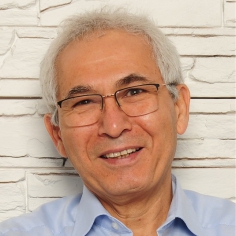
Dr. med. Sadik Öz
Internist
Medical stages
During my studies I regularly spent about 4 years in the premature infant intensive care unit as a night duty student. Although it was regularly not demanded for that long, I completed various practices as a committed medical student over several months in internal medicine, pediatric surgery, anesthesia, and psychiatry. As a so-called PJ in German (a sort of rotating internship), I have been trained in internal medicine (gastroenterology), gynecology and obstetrics as well as septic and aseptic surgery. My training program for internal medicine comprised also manifold areas such as immunology, rheumatology, hematology, oncology, nephrology as well as in the emergency and intensive care units.
Medical education and research (1979 − 1988)
– University of Regensburg (pre-clinical terms).
– University of Erlangen-Nuremberg (clinicle terms), start with doctoral thesis.
– Visiting researcher at Sloan Kettering Cancer Center, New York, USA.
– Pediatric oncology, Hannove.
Medical education for Internal Medicine (1988 − 1995)
– Med. Klinik III, Immunology-Rheumatology, University Hospital, Erlangen.
– Med. Klinik IV, Nephrology, Municipal Hospital, Nuremberg.
– Med. Klinik V, Haemato-Oncology, Municipal Hospital, Nuremberg.
Research activities
My thirst for knowledge is based on the principle of never standing still, avoiding dead ends, treading new paths and always looking out beyond the horizon. My laboratory work started with MLC (mixed lymphocyte culture) and continued through the interleukin-cytokine era, ADCC (antibody-dependent cellular cytotoxicity) with various function tests for neutrophils, NK (natural killer cell) and CTL (cytotoxic T-lymphocyte) assays, monoclonal antibody production, establishment of cell lines up to iREM cancer therapy.
Therefore my publications are in different research topics (see list of publications).
My doctoral thesis provided in the 1980s basic knowledge for the development of a drug (G-CSF) that has been used for decades for leukocytopenia treatment and for the extraction of peripheral stem cells in bone marrow transplants. On the basis of my LW/SO cell line I already proved in 1995 – at the time contrary to the prevailing opinion – that cell commitment and differentiation are not final but reversible phenomena. On the part of scientific establishment I was admonished not to turn the knowledge of cell biology upside down. The groundbreaking character of my observation became apparent in the following years, when numerous publications adopted this idea for stem cell research (by the way, without referring to LW/SO publication). iREM is also an undeniable fact.
PUBLICATIONS
- Einfluss eines kolonie-stimulierenden Faktors der Hämatopoese auf die antikörperabhängige zelluläre Zytotoxizität von menschlichen neutrophilen Granulozyten. Dissertationsarbeit. S. Oez,1985.
- Human pluripotenthematopoietic colony stimulating factor: Activities on human and murine cells. E. Platzer, S. Oez, K. Welte, A. Sendler, J. L. Gabrilove, R. Mertelsmann, M. A. S. Moore, and J. R Kalden. Immunobiol. 172:185-193, 1986.
- Anti-tumor efficacy of interleukin-2-activated killer cells in human neuroblastoma ex-vivo. J. Atzpodien, S. C. Gulati, J. H. Kwon, B. H. Kushner, C. Shimazaki, C. Bührer, S. Oez, J. E. Kolitz, K. Welte, and B. D. Clarkson. Exp. Cell Biol. 56:236-244, 1988.
- Ewing’s sarcoma: Ex-vivo sensitivity towards natural (NK) and lymphokine-activated (LAK) killing. J. Atzpodien, S. C. Gulati, C. Shimazaki, C. Bührer, S. Oez, J. H. Kwon, J. E. Kolitz, and B. D. Clarkson. Oncology 45:437-443, 1988.
- Tumor necrosis factor regulates antibody dependent cellular cytotoxicity (ADCC) of human polymorph nuclear cells. S. Oez, M. Hadam, C. Bührer, E. Platzer, J. Atzpodien, and K. Welte. Cancer Res. Clin. Oncol. 114:146-146, 1988.
- A Quantitative Colorimetric Method to Assess the Functional State of Human Polymorphnuclear Leukocytes. S. Oez, E. Platzer, and K. Welte. Blut 60:97-102, 1990.
- Establishment and characterization of a granulocyte-macrophage colony-stimulating factor-dependent human myeloid cell line. S. Oez, H. Tittelbach, R. Fahsold, R. Schaetzl, and J. R. Kalden. Blood 76:578-582, 1990.
- A highly sensitive quantitative bioassay for human granulocyte- macrophage colony-stimulating factor.S. Oez, J. Atzpodien, C. Bührer, and J. R. Kalden. Exp. Hematol. 18:1108-1111, 1990.
- A simple assay for quantifying the inducible adherence of neutrophils.S. Oez, K. Welte, E. Platzer, and J. R. Kalden. Immunobiol. 180:308-315, 1990.
- Clonal growth of functionally normal and deficient neutrophils from the bone marrow of a patient with variant chronic granulomatous disease. S. Oez, J. Birkmann, and J. R. Kalden. Ann. Hematol. 66:21-25, 1993.
- Granulocyte-macrophage colony stimulating factor (GM-CSF) reduces the density of stem cell factor receptors (c-kit oncogene product) on a GM-CSF dependent human myeloid cell line. S. Oez, G. Hofmann-Wackersreuther, J. Birkmann, M. Smetak, K. Welte, and W. M. Gallmeier. Eur. Cytokine Netw. 4:293-297, 1993.
- Regulation of the density of the stem cell factor receptor (c-kit) by tumor necrosis factor on a human myeloid cell line. S. Oez, J. Birkmann, M. Smetak, S. Corbacioglu, G. Hofmann-Wackersreuther, K. Welte, and W. M. Gallmeier. Eur.Cytokine Netw. 4:439-445, 1993.
- LW/SO cell line: a tool for studying the phenotypical characterization and commitment of hematopoietic stem cells. S. Oez, U. Trautmann, M. Smetak, J. Birkmann, S. Al Salameh, E. Gebhart, and W. M. Gallmeier. Ann. Hematol 72:307-316, 1996.
- Effects of recombinant human thrombopoietin alone and in combination with erythropoietin and early-acting cytokines on human mobilized purified CD34+ progenitor cells cultured in serum-depleted medium. J. Birkmann, S. Oez, M. Smetak, G. Kaiser, H. Kappauf, and W. M. Gallmeier. STEM Cells 1997;15:18 32.
